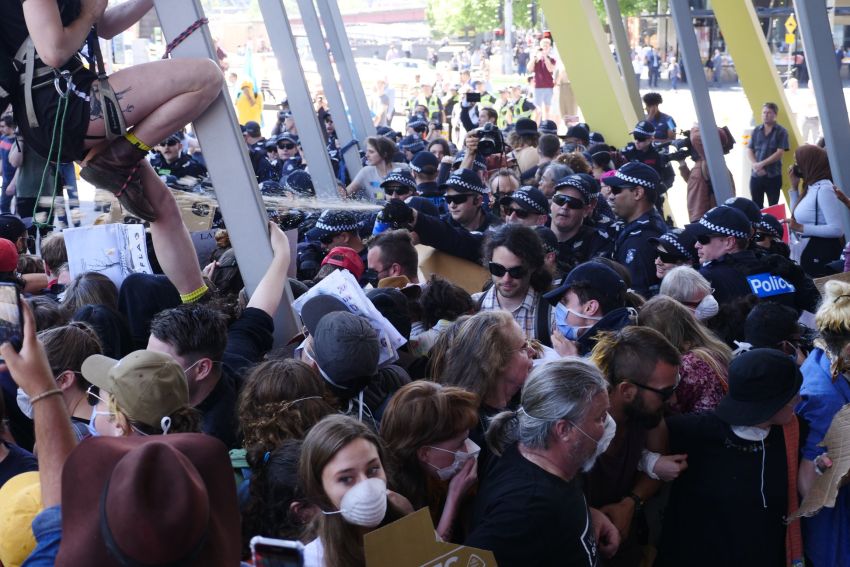
I attended the peaceful blockade of the International Mining and Resources Conference (IMARC) and witnessed how Victoria Police brutally attacked protesters with chemical foam and pepper spray on October 30.
Around lunchtime, two activists had climbed poles outside the conference venue to hang an anti-IMARC banner as First Nations and migrant community members talked about anti-mining struggles in Australia and other parts of the world. The climbers did not damage any property and were in no way violent.
With the rally finishing up and people leaving, the climbers began to descend. Police then decided to send in a snatch squad to arrest the two.
Many of us had heard reports of police using heavy-handed tactics when arresting protesters throughout the four-day protest. A friend of mine had a group of police use his face as a battering ram to open a large heavy glass door, after they taunted him with homophobic slurs.
So upon seeing police move in to make more arrests, protesters reassembled to protect the climbers.
Realising they were outnumbered and surrounded, the snatch squad retreated. They retreated not because of any threat of violence — no one punched or threatened the police — but because of the display of mass, peaceful solidarity by protesters.
Then came the hot-headed revenge attack. Police were determined to arrest the two climbers and if they had to carve a path through the crowd using pepper spray, then that is what they were going to do.
And that is exactly what they did.
Riot police amassed with the police who had just retreated into a wedge formation and charged protesters. They arbitrarily sprayed the crowd of 150-200 people with pepper spray and chemical foam.
Police made a point of re-spraying the face of any protester who did not immediately retreat at point blank range.
More than 60 people had to be treated for pepper spray burns as a result of the attack.
One of the climbers, nearing the ground and incapable of covering her face, got drenched from head to toe in chemical foam. She had no chance of escaping or avoiding being sprayed.
The police were not using the spray to disperse her, as with the other protesters; they wanted to inflict as much pain on her as possible. No doubt, after arresting her, they denied her any medical attention, instead leaving her to endure the agony of the chemical attack.
The protest had finished and everyone was leaving. The police could have also wrapped up for the day. But allowing things to dissipate peacefully would have meant police conceding a small defeat (not arresting the climbers).
The publicly stated aim of the protest was to blockade IMARC, a summit of some of the world’s worst climate criminals, who gathered to discuss how best to dispossess people from their land and dig out the minerals below in the cheapest and nastiest way possible.
To do this, protesters linked arms and surrounded as much of the venue as we could. We sought to use our bodies to disrupt a conference whose aim is to promote projects that destroy rivers, communities, workers’ lives and the climate.
Disruption is not convenient — but nor is it violence.
Police regularly tried to break the blockade and when they could not, they started pepper spraying and arresting protesters. They also used horses to push through us and snatch squads to grab sound equipment and arrest organisers.
In a media statement afterward, police commander Libby Murphy congratulated police for their “restraint”. In reality, it was the protesters who were restrained in the face of unhinged police brutality.
When police were first given pepper spray, we were told it was a weapon of last resort, to be used only in very dangerous situations as an alternative to a gun.
Activists warned it would not take long for police to start using it on protesters. Given Victoria Police's new arsenal of crowd control guns and rubber pellet grenades, perhaps it will not be long before we see also those deployed at protests.
The craven spinelessness of the state Labor government, which came out in support of the police actions, is sadly not surprising. It comes just weeks after their Queensland counterparts, who have demonised climate protesters as “criminals”, passed new laws further restricting the right to protest.
If there was one positive to come out of the police brutality, it is that those who were at the blockade refuse to be intimidated and demonstrated they are not walking away from the struggle anytime soon.
Rather, the experience only helped to further galvanise their convictions.
We are facing a climate and ecological crisis. That is why we protested at IMARC. And that is why we will continue to mobilise until we tear this rotten system to the ground.
As Greta Thunberg says: “Change is coming whether you like it or not”.